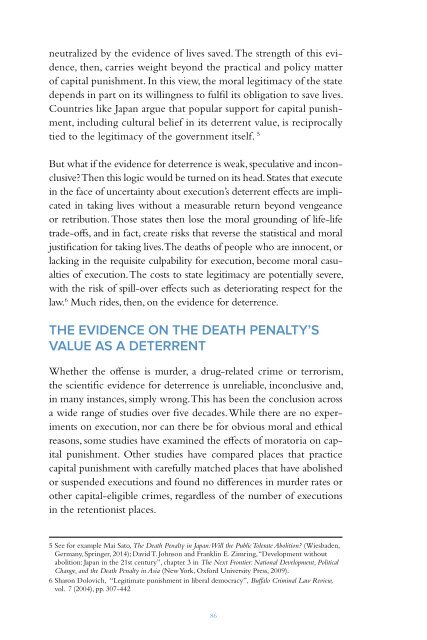PENALTY
DBk0302s7Xm
DBk0302s7Xm
Create successful ePaper yourself
Turn your PDF publications into a flip-book with our unique Google optimized e-Paper software.
neutralized by the evidence of lives saved. The strength of this evidence,<br />
then, carries weight beyond the practical and policy matter<br />
of capital punishment. In this view, the moral legitimacy of the state<br />
depends in part on its willingness to fulfil its obligation to save lives.<br />
Countries like Japan argue that popular support for capital punishment,<br />
including cultural belief in its deterrent value, is reciprocally<br />
tied to the legitimacy of the government itself. 5<br />
But what if the evidence for deterrence is weak, speculative and inconclusive?<br />
Then this logic would be turned on its head. States that execute<br />
in the face of uncertainty about execution’s deterrent effects are implicated<br />
in taking lives without a measurable return beyond vengeance<br />
or retribution. Those states then lose the moral grounding of life-life<br />
trade-offs, and in fact, create risks that reverse the statistical and moral<br />
justification for taking lives. The deaths of people who are innocent, or<br />
lacking in the requisite culpability for execution, become moral casualties<br />
of execution. The costs to state legitimacy are potentially severe,<br />
with the risk of spill-over effects such as deteriorating respect for the<br />
law. 6 Much rides, then, on the evidence for deterrence.<br />
THE EVIDENCE ON THE DEATH <strong>PENALTY</strong>’S<br />
VALUE AS A DETERRENT<br />
Whether the offense is murder, a drug-related crime or terrorism,<br />
the scientific evidence for deterrence is unreliable, inconclusive and,<br />
in many instances, simply wrong. This has been the conclusion across<br />
a wide range of studies over five decades. While there are no experiments<br />
on execution, nor can there be for obvious moral and ethical<br />
reasons, some studies have examined the effects of moratoria on capital<br />
punishment. Other studies have compared places that practice<br />
capital punishment with carefully matched places that have abolished<br />
or suspended executions and found no differences in murder rates or<br />
other capital-eligible crimes, regardless of the number of executions<br />
in the retentionist places.<br />
5 See for example Mai Sato, The Death Penalty in Japan: Will the Public Tolerate Abolition? (Wiesbaden,<br />
Germany, Springer, 2014); David T. Johnson and Franklin E. Zimring, “Development without<br />
abolition: Japan in the 21st century”, chapter 3 in The Next Frontier: National Development, Political<br />
Change, and the Death Penalty in Asia (New York, Oxford University Press, 2009).<br />
6 Sharon Dolovich, “Legitimate punishment in liberal democracy”, Buffalo Criminal Law Review,<br />
vol. 7 (2004), pp. 307-442<br />
A. Murder<br />
From 1972 to 1976, there was a moratorium on capital punishment<br />
in the United States, inspired in part by growing doubts about its<br />
deterrent effect on murder. 7 Executions resumed following publication<br />
of research claiming that the death penalty did in fact deter<br />
homicides—in fact, that each execution deterred as many as eight<br />
homicides. 8 But that evidence was strongly contested, and a 1978<br />
panel of the National Academy of Sciences found little evidence that<br />
claims of deterrence were accurate. 9 Still, belief in deterrence was<br />
politically and culturally popular, even if scientific evidence didn’t<br />
support it. 10 The belief in deterrence persisted for over two decades,<br />
despite the fact that murder rates rose dramatically in the 1980s just<br />
as executions were increasing.<br />
Two factors undermined those beliefs. First, while the murder rate<br />
began declining sharply in the second half of the 1990s, at the same<br />
time that executions rose sharply, the decline in the murder rate continued<br />
after executions declined sharply in 2000. Second, a large body<br />
of statistical evidence emerged showing that the claims of deterrence<br />
advanced in the early 2000’s were deeply flawed. My own research<br />
showed that the decline in murders starting in 1996 was no greater<br />
in states that continued to sentence and execute murderers than in<br />
states that did not. 11 This included states with a formal moratorium<br />
and states with a de facto moratorium such as California, Illinois and<br />
Pennsylvania, which had large numbers of condemned prisoners but<br />
almost no executions. In those places, despite the absence of executions,<br />
murder rates declined sharply.<br />
7 Furman v. Georgia, 408 U.S. 238, 315 (1972) (Marshall, concurring).<br />
8 Issac Ehrlich, The deterrent effect of capital punishment: A question of life and death”, The American<br />
Economic Review, vol. 65, pp. 397-417 (1975).<br />
9 For a summary, see Brian A. Forst, “Capital punishment and deterrence: Conflicting evidence”,<br />
Journal of Criminal Law and Criminology, vol. 74, pp. 927-942 (1983). See, also, Lawrence R.<br />
Klein, Brian Forst, & Victor Filatov, “The Deterrent Effect of Capital Punishment: An Assessment<br />
of the Estimates”, pp. 336-60 in Alfred Blumstein, Jacqueline Cohen and Daniel Nagin (eds),<br />
Deterrence and Incapacitation: Estimating the Effects of Criminal Sanctions on Crime Rates. Washington,<br />
DC: National Academy of Sciences (1978)<br />
10 Samuel R. Gross, Public opinion on the death penalty: It’s getting personal”, Cornell Law Review,<br />
vol. 83 (1998): pp. 1448-1479<br />
11 Jeffrey Fagan, Franklin E. Zimring, and Amanda Geller. “Capital punishment and capital murder:<br />
Market share and the deterrent effects of the death penalty.” Texas Law Review, vol. 84 pp. 1751 -<br />
2134 (2005).<br />
86 87


